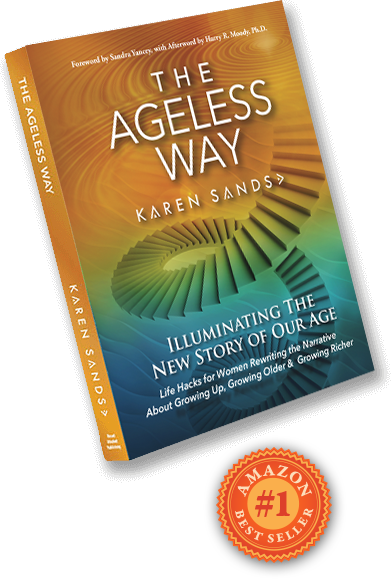Guest post by Harry R. Moody, Speaker, Author, and current Director of Academic Affairs for AARP in Washington, DC

What does it mean to say that Conscious Aging represnts a new form of “growth” in later adulthood? It means that Conscious Aging amounts to a higher level of functioning correlated to the distinct chronological stage of later adulthood. Both level and stage, hierarchy and chronology, are included in this definition of “Conscious Aging.”
“Conscious Aging” has emerged as a social ideal at a specific moment in history, in the first decade of the 21st century. This historical moment reflects the convergence of two historical trends: the evolution of psychology to include humanistic, transpersonal and lifespan development theory; and the widening impact of population aging in all post-industrial societies. The evolution of psychology toward a deeper view of the human person can now join with the societal transformation of institutions to create new opportunities for positive development in later life.
Within this framework of lifespan development theory and transpersonal psychology it is possible to define more precisely what is meant by “positive development” in later life. The psychologist Gisela Labouvie-Vief has drawn a contrast between two very different trajectories of “positive development” in old age (Labouvie-Vief, 2000). The first, which I will label the “holistic” line, is a pathway characterized by increasing integration of divergent elements of the self, both rational and emotional, to yield a more complex structure. This is the process Jung calls individuation, a pathway that includes growing awareness (“conscious aging”) in later life.
Second, there is a trajectory for positive development, which I will label the “adaptation,” characterized by ability to maintain optimal well-being in the face of age-associated losses. This second trajectory is what Rowe and Kahn call “successful aging.” We know from a growing body of research that this second trajectory is correlated with the multiple dimensions of “life satisfaction.”
But what is the relationship between “Conscious Aging” and “Successful Aging?” If they are not exactly the same, how can they be distinguished? Let us begin by saying that the holistic strategy of Conscious Aging is not necessary for positive aging for most people. Conscious Aging represents an option, only one pathway, perhaps not a typical pattern, for coping with the challenges of later life. Many individuals can achieve mental wellness without becoming ever more and more conscious but by simply by adapting themselves to age-related losses and changes. They may age “successfuly” but not “consciously.”
The holistic and the adaptive pathways are both viable but different alternatives to mental wellness in later life. Individuals may combine elements of both coping styles, but they represent distinct trajectories for positive development.
Conscious Aging– the holistic line of development– is not an easy path nor is Conscious Aging likely to appeal to a majority of those entering old age. Far more appealing, we might imagine, would be alternatives such as Successful Aging and Productive Aging. The reason is not hard to imagine. Both alternative strategies of aging represent efforts to sustain or optimize values already enshrined by mainstream culture: namely, “success” and “productivity.”
Both Successful Aging and Productive Aging are strategies for making old age into a “second middle age,” in effect denying the losses of aging altogether. This strategy of denial can be quite effective. Depending on life circumstances, individuals may achieve positive life satisfaction and mental wellness without any greater growth in consciousness or wisdom. They may simply remain themselves, adapting to new conditions but sustained by familiar midlife habits in keeping with Kastenbaum’s definition of aging as “habitatuation” as the beginning of old age (at any chronological age).
By contrast, the strategy of Conscious Aging typically entails a long struggle, described in detail in The Five Stages of the Soul (Moody, 1997). Conscious Aging means going beyond patterns of ego strength acquired during youth and mid-life. This message of struggle is precisely the one that world wisdom traditions have always conveyed. It is a message at odds with today’s culture, in its modern and “post-modern” varieties. Rationality, assertiveness, moral certitude, mastery of the environment, and similar qualities are very different from the stance recommended by spiritual paths such as Zen Buddhism, Sufism, or mystics in the Jewish and Christian traditions. On the contrary, mystical traditions celebrate “the way of unknowing” (overcoming rationality), “emptiness” (giving up self assertiveness), even entering what Buddhists call “the Great Doubt” in the face of cosmic mystery.
Post-conventional spiritual traditions typically entail a “dark night of the soul,” which might be described as “regression in the service of the ego.” In the most profound mystical tradition, the way of transcendence entails at its highest point the “loss of the self:” that is, dissolution of conventional ego structures altogether (Roberts, 1992). At this point there is a stark contrast between opposing tendencies of holistic versus adaptive paths of positive development in later life.
Conscious Aging, as an emerging cultural ideal, represents a genuinely new stage and level of psychological functioning. As a way of life and a level of consciousness, Conscious Aging has appeared at a distinct moment in history. Yet the holistic path of late-life development is not a new idea but a possibility long familiar in the spiritual traditions of the world, which depict later life as a time for the growth of consciousness and wisdom. Still, those same traditions caution us to expect some degree of tension between dominant institutions, with their ruling ideas about “successful aging,” and the more holistic path involved in becoming the person we were meant to be, in becoming more conscious of ourselves and of the cosmic mystery.
This article is adapted from the chapter “Conscious Aging: A Strategy for Positive Development in Later Life” which appears in Judah Ronch and Joseph Goldfield (eds.) Mental Wellness in Aging: Strength-based Approaches, Human Services Press, 2002.







Leave a Reply
You must be logged in to post a comment.